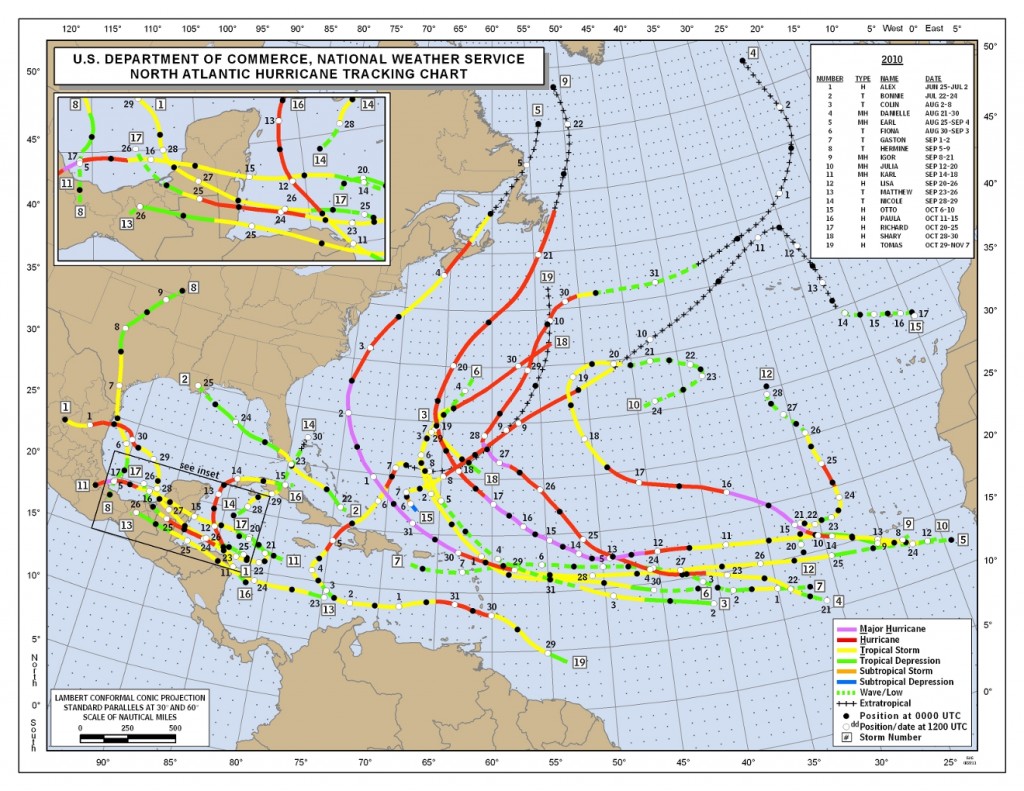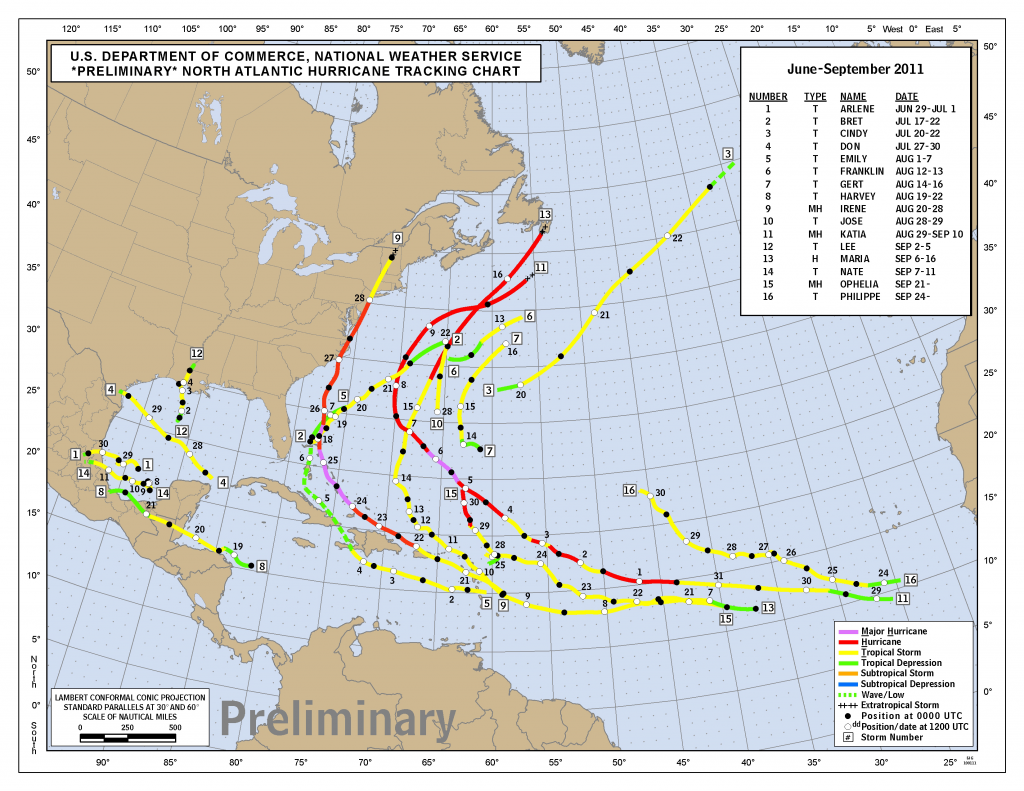7 October 2011
Study shows how warm swath of ocean may keep hurricanes at sea
Posted by kramsayer

In 2010, hurricanes that formed in the eastern Atlantic steered clear of the U.S. East Coast - new research looks into why. (Credit: NOAA)
One hurricane season might pummel the United States, while others bypass it completely – and now scientists have gained a new understanding about why. A team of oceanographers has identified how and why the varying size of a vast body of warm ocean water to the east and south of the U.S. can affect the number of hurricanes that make U.S. landfall. With this new insight, hurricane specialists may someday be able to better predict the likelihood that storms will make landfall during a given hurricane season.
For years, hurricane researchers have observed that storms are more likely to miss the U.S. when the size of the huge swath of warm water called the Atlantic warm pool is much bigger than usual. On average, about 25 percent of all hurricanes hit the United States. But in a year when the Atlantic warm pool is large, the number of hurricanes that make landfall stateside drops by about 40 percent in comparison to a year when the warm pool is small.
The Atlantic warm pool occupies a region comprised of the western tropical North Atlantic, the Caribbean Sea, and the Gulf of Mexico.
Scientists have also previously noted that, during years when the warm pool is large, it expands towards the east. This in turn causes an eastward shift in the location where hurricanes are formed. Accordingly, the chance the storm will make landfall in the United States diminishes, because hurricanes that form farther east are more likely to move north and curve away from land, says Chunzai Wang, a physical oceanographer and climate scientist at the NOAA Atlantic Oceanographic and Meteorological Laboratory in Miami, Fla. and lead scientist on the new study. Indeed, in 2010 only 13.2 percent of storms forming east of 40°W made landfall, as opposed to 29 percent of hurricanes forming west of 40°W, the researchers note. Just why the eastward shift correlates with a land-avoiding trajectory hasn’t been clear.
In the new research, Wang and his colleagues use observational data dating back to 1950, as well as a numerical model, to investigate how the variation in the size of the warm pool alters prevailing air currents that determine a hurricane’s track.
“Where [a] leaf goes depends on where the stream flows,” Wang says. “It’s a similar situation in the ocean.” The trajectories of hurricanes depend on what he calls “atmospheric steering flow,” an air flow in the middle or upper troposphere that dictates the direction of storms at lower levels of the troposphere, and which could be affected by ocean temperature.
In their study, the team calculated how much the steering flow differed from usual during large and small Atlantic warm pool years. They found that the steering flow anomalies in years when the Atlantic warm pool was average size were very small in comparison to years when it was either large or small.
Typically, an axis of high pressure known as the North Atlantic subtropical high causes hurricanes to move towards the west, Wang says. But, in years in which it is weak or shifts northeastward, hurricanes may turn north and then east. Using a computer model of the atmosphere, the researchers showed that sea level pressure associated with the North Atlantic subtropical high is significantly decreased in response to a large Atlantic warm pool. This in turn allows hurricanes to curve to the northeast more frequently, rather than make landfall in the United States.
Wang and his colleagues present their findings in a paper published today (7 October 2011) in Geophysical Research Letters, a journal of the American Geophysical Union.
Other climate factors are also known to impact the likelihood of a hurricane reaching the U.S. coast. For instance, a climate pattern known as La Niña, in which sea surface temperatures drop below normal in a large region of the subtropical Pacific Ocean, tends to increase the likelihood of hurricanes making landfall in the southeastern United States. But, although the 2010 Atlantic hurricane season was extremely active and a La Niña pattern prevailed, no hurricanes made landfall that season.
A sizing up of the 2010 Atlantic warm pool proved revealing. From August through October of 2010, it was about 2.2 times larger than average, Wang and his colleagues report. “Our paper pointed out that although 2010 was a La Niña year, which might help increase the number of Atlantic hurricanes, its effect on landfall was offset by the extremely large Atlantic warm pool in 2010,” Wang writes.

In 2011, the Atlantic warm pool was smaller. Hurricane Irene made landfall in September. (Credit: NOAA)
According to Wang, this year’s Atlantic warm pool is smaller than 2010. This may help explain why there have been more storms that have made landfall during the 2011 hurricane season thus far – with one hurricane and two tropical storms coming ashore in the United States – although the season is not over yet.
Still, the factors controlling hurricane track are complicated, and the correlation between a large Atlantic warm pool and fewer landfalls isn’t ironclad, the researchers note in their paper. Even though the Atlantic warm pool was large in 2005, the hurricane season was an active one, and many of the season’s hurricanes (one third of them) made landfall in the United States.
The new findings about hurricane steering pattern changes are novel but not entirely convincing, says Phil Klotzbach, research scientist for The Tropical Meteorology Project at Colorado State University in Fort Collins, Colo. Klotzbach was not involved with the study.
“You are dealing with a fairly small sample size, so it’s hard to make any huge assertions based on that,” Klotzbach explains. “The models help in that regard. I think once you get more data and have longer time periods, you will be able to see these results much stronger.”
Better understanding of factors influencing hurricane landfall in the United States is both scientifically and socially important, since hurricanes can cause severe damage and losses.
In the future, we might be able to predict the extent of the warm pool in the Atlantic and other ocean basins where hurricanes form, Wang says. And if scientists can predict the Atlantic warm pool’s size, he adds, they might be able to predict how many hurricanes will slam the United States.
![]() Wang, C., Liu, H., Lee, S., & Atlas, R. (2011). Impact of the Atlantic warm pool on United States landfalling hurricanes Geophysical Research Letters, 38 (19) DOI: 10.1029/2011GL049265
Wang, C., Liu, H., Lee, S., & Atlas, R. (2011). Impact of the Atlantic warm pool on United States landfalling hurricanes Geophysical Research Letters, 38 (19) DOI: 10.1029/2011GL049265
– Allie Wilkinson, AGU science writing intern


 GeoSpace is a blog on Earth and space science, managed by AGU’s Public Information staff. The blog features posts by AGU writers and guest contributors on all sorts of relevant science topics, but with a focus on new research and geo and space sciences-related stories that are currently in the news.
GeoSpace is a blog on Earth and space science, managed by AGU’s Public Information staff. The blog features posts by AGU writers and guest contributors on all sorts of relevant science topics, but with a focus on new research and geo and space sciences-related stories that are currently in the news.
I have to agree with Klotzbach, it IS a small sample size.
But, the results from that small sample collection suggests additional study, with larger samples of data and ongoing study, for decades to come.
For then, one would either dispose of an incorrect theory or end up with the gold: A predictive model.
Is there data from past years about the size of the warm pool? This might help to expand the dataset, re: Wzrd1’s comment.
I know that the NHC has a really cool map interface where you can plot tracks of hurricanes since the late 1800s (http://www.csc.noaa.gov/hurricanes/#), but are there similar datasets of the Atlantic warm pool extent? Surely we have been making accurate SST maps long enough to provide a reasonable dataset to test this theory…
[…] may be able to predict the amount of hurricanes coming in contact with the United States. https://blogs.agu.org/geospace/2011/10/07/hurricanes-at-sea/ Wang, C., Liu, H., Lee, S., & Atlas, R. (2011). Impact of the Atlantic warm pool on United […]
[…] https://blogs.agu.org/geospace/2011/10/07/hurricanes-at-sea/ […]